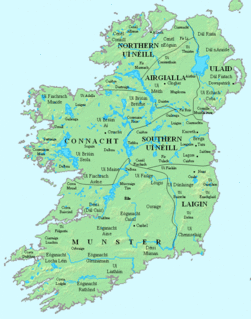Gaillimh inion Breasail is the name of the mythical woman from whom the river and city of Galway, Ireland, derives its name.

Galway is a city in the West of Ireland, in the province of Connacht.

Ireland is an island in the North Atlantic. It is separated from Great Britain to its east by the North Channel, the Irish Sea, and St George's Channel. Ireland is the second-largest island of the British Isles, the third-largest in Europe, and the twentieth-largest on Earth.
According to James Hardiman, quoting Lughaidh Ó Cléirigh, "that the city of Galway took its name from the river, in which was drowned Gaillimh, the daughter of Breasail." Hardiman goes on to state that in the mid-17th map of the town, "a rock is shown in the river" (now called the Corrib), "where" it is stated, that "a woman, named Galva, was drowned, near a great rock, in the river," (which is delineated on the map) "and that from this circumstance the town originally took its name."
James Hardiman (1782–1855), also known as Séamus Ó hArgadáin, was a librarian at Queen's College, Galway.
Lughaidh Ó Cléirigh, sometimes anglicised as Lewey O'Clery, was an Irish Gaelic poet and historian. He is best known today as the author of Beatha Aodha Ruaidh Uí Dhomhnaill, a biography of Red Hugh O'Donnell.

The River Corrib in the west of Ireland flows from Lough Corrib through Galway to Galway Bay. The river is among the shortest in Europe, with only a length of six kilometres from the lough to the Atlantic. It is popular with local whitewater kayakers as well as several rowing clubs and pleasure craft. The depth of this river reaches up to 94 feet.
She was said to be the daughter of a chief of the Fir Bolg, Breasail. It is now generally held that she was a tribal or local goddess of the river, much like other Gaelic deities such as Boann. The etymology of the name is thought to translate, roughly, as stony river, and probably dates back to at least the late Irish pre-historic era.

In medieval Irish myth, the Fir Bolg were the fourth group of people to settle in Ireland. They were descended from the Muintir Nemid, an earlier group who abandoned Ireland and went to different parts of Europe. Those who went to Greece became the Fir Bolg and eventually returned to the now-uninhabited Ireland. After ruling it for some time, they were overthrown by the invading Tuatha Dé Danann.

A goddess is a female deity. Goddesses have been linked with virtues such as beauty, love, motherhood and fertility. They have also been associated with ideas such as war, creation, and death.

The Gaels are an ethnolinguistic group native to northwestern Europe. They are associated with the Gaelic languages: a branch of the Celtic languages comprising Irish, Manx and Scottish Gaelic. Historically, the ethnonyms Irish and Scots referred to the Gaels in general, but the scope of those nationalities is today more complex.





